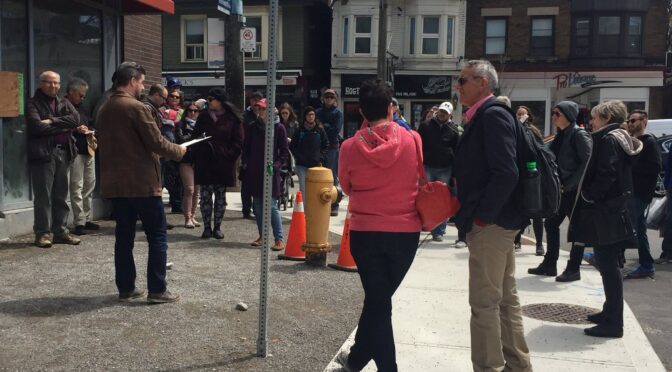…bringing a voice to the community through meaningful public consultation, and taking further steps to gather local opinions to better represent residents’ concerns at council.
If you’ve ever attended a public “consultation”, did you get the feeling that it’s not really about consulting residents, as much as it is to humour them with a forum to speak about concerns that hold no weight?
I’ve been to dozens upon dozens of community consultations over the years, and they generally fall into two categories:
- Actual consultations where the city wants to hear the opinions of residents.
- Presentations where the city is presenting a plan to the public that is not up for debate or revision.
When it comes to building playgrounds or designing way-finding, the city is all ears—wanting to know what residents think. But, when it comes to other issues such as new condo developments or the Woodbine Bike Lanes, the city’s “consultations” are in name only.
The only public input they might consider for projects such as these, are safety concerns.
PUBLIC FEEDBACK IGNORED:
For example:
At one particular consultation, residents raised concerns about the construction hoarding on the sidewalk of the Lick’s development. There was no lighting, and it was quite dark at night. After hearing residents’ concerns, they put up lighting 2 days later.
However, at every other development consultation I’ve been to, when residents speak their valid concerns about the scope, scale, or character of the development and its impacts on the existing neighbourhood, it goes on the record, and those concerns are shelved.
Even when Ward 32 Spokes had feedback at the public consultation for the Woodbine cycle track, our concerns were rebuffed.
City departments do the best they can with the expertise and staff they have. But being an expert in transportation (as an example) doesn’t necessarily give one the understanding of the transportation dynamics of an area they do not live in.
LOCAL INPUT MATTERS:
Local residents have the most to offer when it comes to helping design solutions from the ground up. Consultations should begin BEFORE the city has already spent time and money creating a plan with no input from residents.
City staff might be surprised by the viable ideas that spring from the community.
We have the technology to be gathering information directly from residents, and ways to do so with security and privacy. Residents should be able to easily and regularly have their say in important decisions that affect not only our area, but all of Toronto.
This does not mean we ignore expert advice or evidence in favour of majority opinion when making decisions. It simply means that residents should have more opportunity to voice their opinions directly to elected officials, to be used as part of the decision-making process with city staff prior to changes being made.
COMMUNITY POLLING:
One of the very few examples of direct democracy in our city is the use of community polling. The three most common forms of polling in our ward being when a restaurant wants a patio permit for a side street, a street wants speed humps, or a street wants to change permit parking.
I have a section on direct democracy on this site, and it’s one of the ways residents get a voice beyond voting for their representative every four years.
It was not right, nor does it seem lawful, that the city changed all non-permit streets into permitted streets without any notice or polling. It is claimed that this was a “councillor-led exemption” even though no such clause appears in the bylaw.
I believe in more polling, not less, so residents who have to live with the changes have more say in the shape of their neighbourhood.
As councillor, I will ensure meaningful public consultation that brings residents into the conversation at the ground floor. I will also institute a system of information collection to better understand the opinions of residents.

